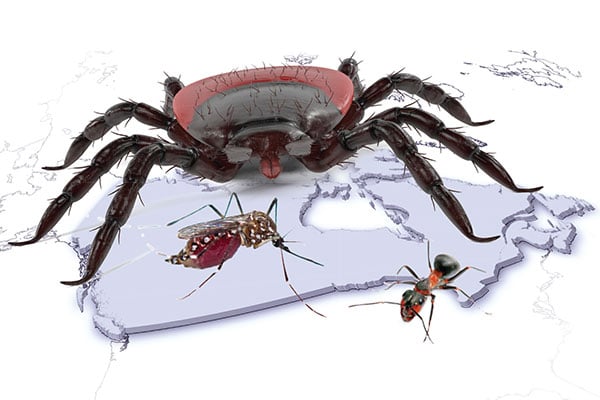Workers must take precautions to prevent debilitating disease, allergic reactions from stinging insects

In June of 1991, Jim Wilson was clearing brush in the back of his house in Dartmouth, N.S. One week later, he noticed an 8-inch bulls-eye rash around his navel. Three months later, on the drive across Canada to his new home in British Columbia, he was extremely fatigued and had to pull over every two hours for a nap. His knees started to give out and there was a lot of numbness and tingling in his legs. Over the next three years, Wilson declined rapidly. He could no longer function in his previous career as an independent insurance adjuster, he was choking on his food, drooling when he spoke and his memory was fading. He was bounced from specialist to specialist but no one knew what was wrong. Fed up with seeing her husband deteriorate so severely, Wilson’s wife went to the local library to research chronic diseases, and she came across a book about Lyme disease.
“It was just a blueprint for everything I had been through,” says Wilson, who is the founder and president of the Canadian Lyme Disease Foundation (CanLyme) based in West Kelowna, B.C.
Wilson was able to locate a doctor in B.C. with expertise in Lyme disease, and after the five-hour drive to his office and a 2.5-hour appointment, Wilson was diagnosed with Lyme disease.
“It (had been) terrifying because I thought I was dying and nobody knew why. And to have a diagnosis… and finally after the third or fourth week the antibiotics seemed to kick in and then I started having good days and more good days and it was nice to have that light at the end of the tunnel,” he says.
Lyme disease is an infection that spreads to humans through tick bites. The disease is on the rise in Canada and spreading rapidly. The number of cases reported in Canada has increased from 144 cases in 2009 to 917 cases in 2015, according to data from the federal government. But CanLyme believes the number is much, much higher, somewhere in the neighbourhood of 5,000 to 10,0000 annually, Wilson says. The large discrepancy is due to an “extremely poor” surveillance model.
“The medical community is largely still in a state of denial about it,” Wilson says.
According to Wilson, the majority of physicians across the country will not give a Lyme diagnosis unless an individual had been in a known endemic area. For example, an individual who lived in a small Quebec town that is not a known endemic area — but that borders the highly endemic New York state — could not get his doctor to test him for Lyme disease. The man then went to New York where he tested positive for Lyme.
Lyme endemic areas can be found in parts of British Columbia, Manitoba, Ontario, Quebec, New Brunswick and Nova Scotia. But anyone, anywhere can be affected, cautions Wilson.
“There really is no safe place in Canada any longer.”
Tying diagnosis to a known endemic area does not accurately reflect how the disease is spread. Migratory birds, such as robins, wrens and sea birds, move hundreds of millions of ticks around each season. Their migratory flyway brings them from the very highly endemic regions of the northern United States to Canada.
“A robin could be in a field on the Hudson River Valley, New York, picking up infected ticks on a Thursday and that same bird could be in your backyard in Toronto by Saturday dropping off these infected ticks,” Wilson says. “They also carry the disease in their blood to infect any ticks that feed on them along the way.”
Doctors are often looking for a tell-tale bulls-eye rash to diagnose Lyme disease, but only nine per cent of Lyme patients develop this, according to CanLyme.
Symptoms of Lyme disease usually occur within one to two weeks, but can occur as soon as three days or as long as a few months after the tick bite. Symptoms may initially resemble the flu — sore throat, fever, headaches, fatigue, congestion and stiffness.
There are over 100 different symptoms of Lyme disease that vary from patient to patient and often resemble other illnesses, so misdiagnosis is common. Many Lyme victims have been misdiagnosed as having irritable bowl syndrome, chronic fatigue, fibro myalgia, muscular sclerosis, Parkinson’s and Alzheimer’s.
If caught early, Lyme can be treated with several rounds of antibiotics, often changing antibiotics throughout treatment. If the disease goes untreated, it will disseminate quite quickly throughout the body, making it much more difficult to treat.
If a worker has symptoms resembling Lyme disease, she should be thoroughly evaluated by her doctor, making sure to mention her outdoor occupation and the area where she has been working. It’s also important to not just rely on blood tests because they are not very effective, says Wilson. According to CanLyme, Canada’s Lyme testing methods are flawed. False negative test results are common, especially in the early stages of Lyme.
Any company with outdoor workers — foresters, engineers, tree planters, construction workers, fishers, camp counsellors, grounds keepers, landscape workers, firefighters, police officers and parks workers — need to make sure their workers are protected from contracting Lyme disease. As much as they can, workers should stay out of brushy areas, tall grass, moist and shaded environments and leafy wooded areas. Baby (nymph) ticks are a concern in spring and early summer when they are feeding, which CanLyme believes is the most common time when people are infected. The ticks are only the size of a poppy seed during this stage. However, it’s important to note that ticks can be found at any time of the year when the temperature is above freezing.
When feeding, ticks climb up no more than 18 inches above the ground, put their feelers out — which are kind of like Velcro — and latch on to any warm blooded mammal that brushes past, including humans.
Workers need to be educated on the risks that ticks pose and how to avoid them. TimberWest discusses Lyme disease prevention at its general safety meetings, says Tammie Wheeler, administrative and safety co-ordinator at the large timberland company in Nanaimo, B.C. Workers are given tips on how to prevent tick bites, such as tucking their pants into their work boots and tucking their shirts in.
“Make sure the whole body is covered in clothing and tightly wrapped,” she says.
CanLyme recommends light-coloured clothing so ticks can be easily spotted.
Ideally, workers should change outside, shake off their clothes and then put them in the dryer for 15 minutes — and that will kill any tick, says Wilson. A big problem is carrying these ticks into the workplace or home on clothing, he adds, so make sure to check any gear or equipment for ticks.
TimberWest workers are encouraged to do body inspections to check for ticks, says Ken Dodd, operations manager, south island, at TimberWest. A thorough check is important because ticks will often climb upwards until they find exposed skin. The Ontario Ministry of Labour recommends paying close attention to areas such as the scalp, ankles, armpits, groin, naval and behind the ears and knees.
TimberWest also informs workers on what to do if they find a tick on them.
“They can’t just rip it out and be done with it,” Dodd says. “If they encounter something, they need to make sure it’s extracted properly.”
If a tick has attached itself to you, the instinct is to just brush it off or grab it and get it out, but this can leave the head of the tick in your skin, says Liz Swift, senior environment advisor at Cenovus Energy in Calgary. The proper method is to grasp it with tweezers, very close to the skin, then pull in a firm, upward motion to make sure everything is out, she says.
When the tick is removed, it’s recommended to keep it and send it to a public health laboratory in your area that has a tick identification and testing program in place. Many provinces have such a program to help them understand how blacklegged ticks — the most common Lyme carriers — have spread in Canada and the risk of human exposure to Lyme disease.
Employees should notify their employer if they find a tick on them, so that other workers can be made aware of the hazard.
CanLyme sells tick removal kits that companies have been buying in large batches for their first-aid kits or vehicle glove boxes. The kit includes removal instructions as well as three styles of tick removers, tick identification cards, magnifying glass, antiseptic wipe and a container for the tick body.
Once the tick is successfully removed, the worker needs to go to the hospital or his doctor right away to get tested for Lyme disease, Wheeler says.
While Lyme disease is covered in most provinces under workers’ compensation legislation, many boards “deny the existence” of Lyme disease, says Wilson.
“They have their own favourite doctors that they send you to and the doctors say, ‘There’s no such thing as chronic Lyme,’ so there’s no coverage, and they end up either losing their jobs completely or losing their homes. They certainly lose their incomes,” he says, adding CanLyme knows of many people across Canada with ongoing battles against workers’ compensation boards and employee disability insurers.
“The underwriters of insurance policies and the workers’ compensation plans do not want to cover the cost of this rapidly growing phenomena, so they turn it down.”
Wilson says there have been several fishy cases surrounding Lyme disease and workers’ comp. For example, he recalls a handful of parks workers in Waterton Lakes National Park in Alberta came down with Lyme-like symptoms about a decade ago. They were all sent to one infectious disease doctor in Calgary who said they did not have the disease and therefore were all denied workers’ compensation coverage. However, over the following few years, the workers went to other specialists and were diagnosed with Lyme.
While not all ticks carry Lyme disease no tick is a good tick, says Wilson. Some ticks can also transmit Rocky Mountain spotted fever, which can cause serious damage to internal organs, such as the kidneys and heart. Symptoms usually start two to 14 days after the tick bite and include fever, headache, muscle and joint aches, nausea and vomiting, according to the government of Alberta. A rash that looks like many tiny, flat, purple or red spots may appear first on the wrists and ankles, spreading to the rest of the body.
Stinging insects
Ticks are not the only insects that cause issues for outdoor workers. Stinging insets such as bees, wasps and hornets are a hazard as well. When wasps are prevalent at certain times of the year, TimberWest will discuss the risk during its tailgate conversations, says Dodd. If workers notice a lot of nests in a certain area, the company will recommend they stay away from that location, says Wheeler.
It’s recommended to avoid wearing fragrances, such as hairspray, perfume, cologne and scented shampoo or soap because these can attract insects, says Mark Little, volunteer commissioner for Scouts Canada – Chinook Council and senior vice-president of health and safety at Cenovus.
Food can also be an attractant, especially high sugar foods such as fruit, candy and pop. Food should always be kept in a secure location and garbage must be properly disposed of, says Swift.
If a stinging insect is flying around, workers should remain calm because swatting at it may cause it to sting. If a worker is stung, the site of the sting should be cleaned with cleansing wipes (in the absence of soap and water). Unlike wasps and hornets, when a bee stings, it leaves its sting in the skin. The sting should be removed right away since the venom can still be injected for up to a minute after the bee detaches from it. The Canadian Centre for Occupational Health and Safety (CCOHS) recommends removing the sting by scraping sideways with a fingernail or a credit card.
Calamine lotion or ice packs can be applied to stop the itching, and over-the-counter pain relievers can help decrease discomfort. TimberWest workers have Benadryl in their personal first-aid kits that they wear in the field and in their vehicle kits.
Generally, most stings will only result in temporary pain, swelling and skin redness around the affected area. But sometimes the effects can be more severe. If a worker is stung in the neck, it may cause edema (swelling caused by fluid build-up in the tissues) around the throat and may make it difficult to breathe, according to CCOHS.
If a worker is stung, his co-workers should be made aware so they can monitor him for any adverse effects.
The main concern with stinging insects is an allergic reaction, says Gerard Messier, training and program development advisor for the BC Forest Safety Council in Nanaimo, B.C. Anaphylactic shock might set in, which is life threatening. Symptoms include difficulty breathing, swollen eyelids, hives, wheezing, hoarse voice, dizziness, shock or cardiac arrest.
According to CCOHS, of those who die from a severe allergic reaction to a sting, one-half die within 30 minutes and three-quarters within 45 minutes.
While many allergic workers will know they are at risk and carry an EpiPen with them, others might not know how they are going to react to a wasp or bee sting, says Messier.
“People might think ‘I don’t have an allergy, I will be fine. I have been stung by a bee or bitten by a wasp before and I was okay.’ But you never know how you are going to react because it might depend where it stings you. If it stings you on the face or neck, that might be different than if it stung you on the leg,” he says.
If the worker has an anaphylactic reaction, he needs to be taken to the hospital as soon as possible.
TimberWest requires all allergic employees notify their co-workers, says Dodd. All field workers have first-aid training and they know how to recognize the symptoms of an anaphylactic occurrence, he adds.
“We insist if you are anaphylactic and you are packing an EpiPen you do talk to your work partner and say ‘Hey, I am anaphylactic; it is an issue’ and that they do share with their partners how to apply, how to administer an EpiPen if it does become necessary,” Dodd says.
There is a wide variety of technology available to assist workers in the event of an emergency. For example, workers can be armed with panic alarms where they simply hit a button to activate the company’s emergency response plan. TimberWest’s engineers have this type of button.
“For a lot of our foresters and engineers who are typically working by themselves or even if they have a partner, they could be anywhere in a 40 hectare block, you go this way, I go that way, we meet at lunch type of thing… If everything is okay I can push one button, if I am in trouble but it’s not a dire emergency, I need help, I can push another button and if it’s a 911, you can push a third button and there’s coverage where you can initiate a search and rescue type organization to come looking for you,” says Dodd.
Lone worker check-in systems are also useful because if the worker does not call-in when he is supposed to, the employer or a third party service provider will activate the company’s emergency response procedures.
More advanced lone worker monitoring systems are enabled with “man-down” detection. Built-in accelerometers can tell if a worker is no longer moving and a GPS identifies the worker’s location. This information can then be relayed in real-time to the employer or the service provider to initiate emergency response.
Mosquitos can also transmit diseases to outdoor workers, such as West Nile virus. At its peak in 2007, West Nile virus was confirmed in 2,215 individuals across Canada. In 2015, just 80 cases of West Nile were reported.
Prevention is of course the best bet, so workers should be wearing long sleeves and long pants tucked into their work boots, says Swift. In some cases, workers may want to wear a net over their heads as well.
“When we have field workers that are out a little more remotely and will be out there for the day, we will encourage them to wear something that also provides that protective barrier around the head,” she says.
Workers should be using an insect repellent with at least 20 per cent DEET. The employer will often supply workers with bug spray.
“In essence, it’s a form of personal protective equipment, if you think about it — it’s an administrative control,” says Little. “You would not only be looking to have provision of the right equipment, which would include clothing, safety hard hats and all that sort of good stuff, as well as those sorts of preventative chemicals.”
The concern posed by insect bites or stings is not just the health effects it can have on the worker, but the distraction it poses.
“Anything that has potential to sting you, it has potential to cause issues with the worker, whether that just ends up being a tender spot on their arm that takes their mind off task or whether it ends up being an annoyance that causes them to lose focus on what they’re doing,” says Swift.
A big challenge safety managers face when they have outdoor workers is that the environment is always changing. They need to train and educate their workers on the different risks they may face throughout the seasons, says Messier.
“It’s not an environment where you can say ‘Here is the procedure. If you follow this procedure, everything will be fine because the environment changes so often,” he says. “It’s very challenging, very different from an environment where you are in a saw mill or a manufacturing facility where things are pretty consistent on a day-to-day basis.”
Safety managers may also need a gentle reminder to consider the chronic illnesses that can be caused by ticks or insects. Little suggests combining the occupational health, wellness and safety teams to ensure all aspects of the worker are taken care of — and don’t forget to make sure all systems are in place for medical care, short-term disability and long-term disability, too.
“Typically, occupational health and safety focuses on the immediate hazard and incident occurring but you also have to be aware of the longer term effects of exposure, whether that be plants, environment or Lyme disease.” Little says. “You need to be thinking of that.”
Amanda Silliker is the editor of Canadian Occupational Safety.
This article originally appeared in the June/July 2017 issue of COS.





